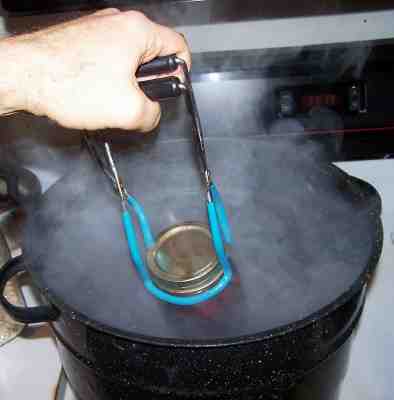
Looking for How to Make Fig-Strawberry Jam with Jello Gelatin - Easily! in 2025? Scroll down this page and follow the links. And if you bring home some fruit or vegetables and want to can, freeze, make jam, salsa or pickles, see this page for simple, reliable, illustrated canning, freezing or preserving directions. There are plenty of other related resources, click on the resources dropdown above. If you are having a hard time finding canning lids, I've used these, and they're a great price & ship in 2 days.
If you have questions or feedback, please let me know! There are affiliate links on this page. Read our disclosure policy to learn more.
How to Make Fig-Strawberry Jam with Jello Gelatin - Easily!
How to Make Homemade Fig-Strawberry Jam with Jello (Gelatin) - Easily!
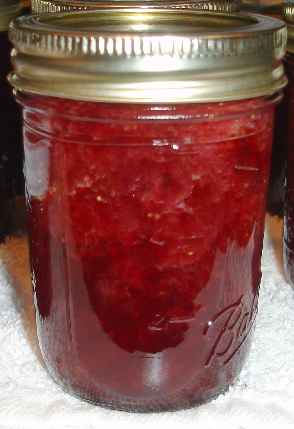 Making
and canning your own strawberry-fig jam with jello is quite easy. Here's how to do it, in 11
easy steps and completely illustrated. The fig and strawberry combination is
a perfect match: the sweetness of figs coupled with the tartness and
aromatic flavor of strawberries is ideal, allowing you to use much less
sugar or even go sugarless! This recipe is all-natural, using fresh or
frozen strawberries an figs. If you want to make
strawberry-fig jam without
gelatin (my preference) click here for that recipe.
Making
and canning your own strawberry-fig jam with jello is quite easy. Here's how to do it, in 11
easy steps and completely illustrated. The fig and strawberry combination is
a perfect match: the sweetness of figs coupled with the tartness and
aromatic flavor of strawberries is ideal, allowing you to use much less
sugar or even go sugarless! This recipe is all-natural, using fresh or
frozen strawberries an figs. If you want to make
strawberry-fig jam without
gelatin (my preference) click here for that recipe.I've got some other pages for specific types of jam, too: See this page for Fig Jam, this page for Blueberry Jam directions and this page for how to make apricot, peach, plum or nectarine jam.
For more information about figs and strawberries, see Fig Picking Tips, Strawberry Picking Tips and Miscellaneous strawberry facts. Also, see this page for directions about how to can figs and this page for strawberry and other berry jams!
For easy applesauce or apple butter directions, click on these links.
Ingredients and Equipment
- Fruit - preferably fresh figs and strawberries, but frozen (without added sugar or syrup works, too) You will need 3 cups of figs and 1 cup of strawberries, in total, of prepared (peeled, chopped) fruit. You may use frozen fruit! Some people skip the strawberries.
- Gelatin (Strawberry flavored Jello) -(it's a natural product, made from...
well, you probably don't want to know...
if you do, click here).
Most of us know it by its brand name, Jello. 2 packages (3 oz. each) of
strawberry gelatin are what you need.
You could use regular or sugarless type of Jello.
- Sugar - 3 cups of dry, granulated (table)
sugar. I haven't tried making it without adding sugar, so I can't tell
you if it would still set if you omitted the sugar and just added 1 cup
of honey, 1 cup of juice (white grape
or peach work best), 1 cup Splenda or about 1/3 cup of Splenda instead
of sugar. Sugar isn't used for its preservative properties, so
safety shouldn't be compromised, but the appearance, flavor, set and
color most likely would suffer.
- Jar grabber (to pick up the hot jars)- Big box stores and grocery stores sometimes carry them; and it is available online - see this page. It's a tremendously useful to put jars in the canner and take the hot jars out (without scalding yourself!). The kit sold below has everything you need, and at a pretty good price:
-
- Jar funnel ($5 at Target, other big box stores, and often grocery stores; and available online - see this page) or order it as part of the kit with the Jar grabber .
- At least 1 large pot; I prefer 16 to 20 quart Nonstick ceramic coated pots for easy cleanup.
- Large spoons and ladles,
- 1 Water Bath Canner (a huge pot to sanitize the jars after filling (about $30 to $35 at mall kitchen stores, sometimes at big box stores and grocery stores.). Note: we sell canners and supplies here, too - at excellent prices - and it helps support this web site!
- Half pint canning jars (Grocery stores, like Publix, Kroger, Safeway carry them, as do some big box stores - about $7 per dozen 8 ounce jars including the lids and rings)
- Lids - thin, flat, round metal lids with a gum binder that seals them against the top of the jar. They may only be used once.
- Rings - metal bands that secure the lids to the jars. They may be reused many times.
Optional stuff:
- Lid lifter (has a magnet to pick the lids out of the almost-boiling water where you sanitize them. ($4 at big box stores or it comes in the kit at left)
Jam-making Directions
Step 1 - Pick the figs and berries! (or buy them already picked)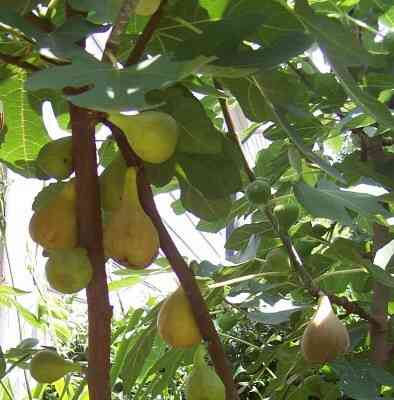
It's fun to go pick your own and you can obviously get better quality ones!
At right is a picture I took of Brown Turkey figs - they are plentiful in late August throughout the South. Other types of figs are fine, too. Strawberries are usually in season in May or June in most areas, so you may want to pick and freeze your strawberries (without sugar) and make this jam when the figs come in season. See this page on freezing strawberries.
I prefer to grow my own; which is really easy, especially for figs, strawberries can more challenging - but growing anything does take some space and time. That's why we have pick-your-own farms!
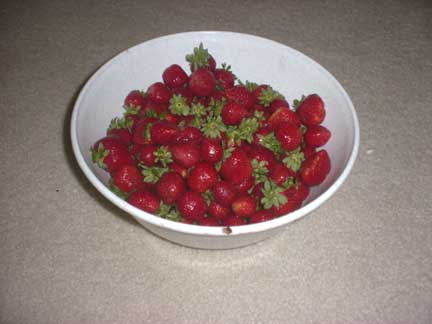 As
mentioned above; you may use frozen figs or berries (those with or without syrup or
added sugar); which is especially useful if you want to make some jam in
December to give away at Christmas!
As
mentioned above; you may use frozen figs or berries (those with or without syrup or
added sugar); which is especially useful if you want to make some jam in
December to give away at Christmas!
Above and at left are strawberries that I picked at a pick-your-own farm. If you want to pick your own, here is a list and links to the pick your own farms.
How much fruit?
Gelatin jams are made in rather small batches - about 3 or 4 cups of prepared fruit at a time - The gelatin doesn't set up well otherwise.
Step 2 - Wash the jars and lids
Canning jars in the dishwasherNow's a good time to get the jars ready, so you won't be rushed later. The dishwasher is fine for the jars; especially if it has a "sanitize" cycle, the water bath processing will sanitize them as well as the contents! If you don't have a dishwasher with a sanitize cycle, you can wash the containers in hot, soapy water and rinse, then sanitize the jars by boiling them 10 minutes, and keep the jars in hot water until they are used.
NOTE: If a canning recipe calls for 10 minutes or more of process time in the canner, then the jars do not need to be "sanitized" before filling them. But really, sanitizing them first is just good hygeine and common sense! See this page for more detail about cleaning and sanitizing jars and lids.
Put the lids into a pan of hot, but not quite boiling water (that's what the manufacturer's recommend) for 10 minutes, and use the magnetic "lid lifter wand" to pull them out. Leave the jars in the dishwasher on "heated dry" until you are ready to use them. Keeping them hot will prevent the jars from breaking when you fill them with the hot jam.
Step 3 -Wash and hull the strawberries!
The old time recipe does not use any fresh strawberries; just the strawberry-flavored Jello. If you want to do that, you may omit the strawberries, and skip this step.
If you are using strawberries,
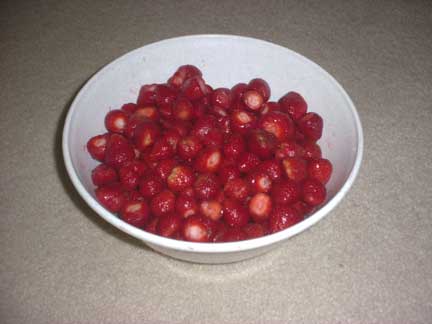 I'm
sure you can figure out how to wash the fruit in plain cold water.
I'm
sure you can figure out how to wash the fruit in plain cold water.
With strawberries you must remove the hulls (green parts), and the slice the berries into halves (for small berries) quarters for large berries.
Step 4 - Peel and chop the figs
You need to cut off the stems and the bottom of the
fig, but you do not need to peel them - you CAN peel them if you
want to. I only peel the grody* looking ones (example photo below)
or those with thick skins.
(* knarly, gross, yucky)
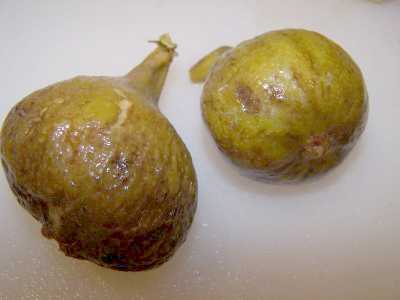
At left, sample figs with unappealing peels (skins). If the skin looks fine, I chop it up, but if the skins are tough, think or unappealing like these...
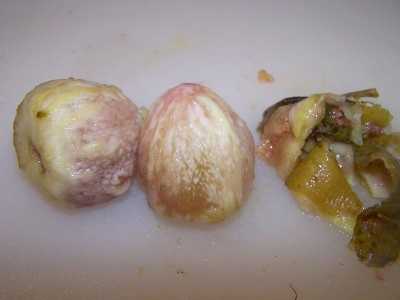
I peel ----->
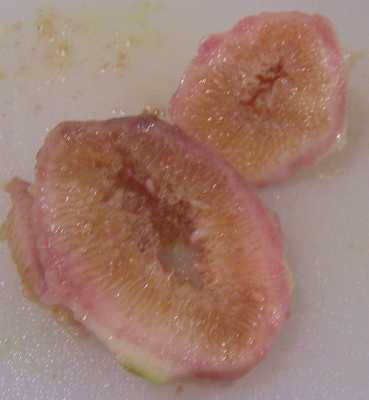 At
left is a sample slice of a perfectly ripe but not over-ripe fig. It
depends on the variety, but generally, they should be pink/yellowish and not
brown inside....
At
left is a sample slice of a perfectly ripe but not over-ripe fig. It
depends on the variety, but generally, they should be pink/yellowish and not
brown inside....
Some recipes call for the figs to sit in boiling water for 5 to 15 minutes
to "check o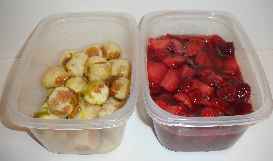 r
tenderize the skins. Since the skins have no flavor, I'd rather remove
them if they are thick or tough... otherwise, just chop them up along with
the rest of the fig.
r
tenderize the skins. Since the skins have no flavor, I'd rather remove
them if they are thick or tough... otherwise, just chop them up along with
the rest of the fig.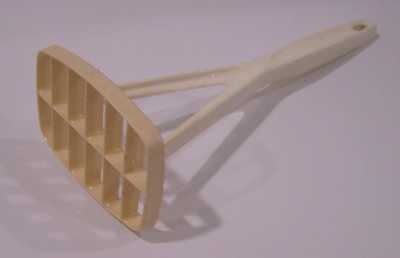 I do remove any stems and bruised spots.
I do remove any stems and bruised spots.
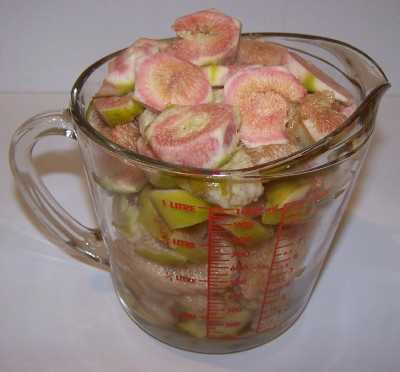 You will need 3 cups of the prepared (chopped) figs. You can chop them up more, if
you like, but I find they soften and break up during cooking, an
You will need 3 cups of the prepared (chopped) figs. You can chop them up more, if
you like, but I find they soften and break up during cooking, an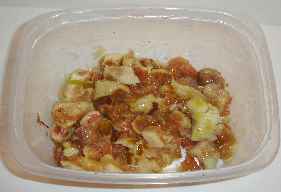 d
if I want smaller pieces, I just use a sharp-edged plastic potato masher
(shown at right) to mush them while cooking)
d
if I want smaller pieces, I just use a sharp-edged plastic potato masher
(shown at right) to mush them while cooking)
You should now have 1 cup of sliced strawberries and 3 cups of chopped figs! I suspect you could vary the ratio, as long as the total amount of fruit is 4 cups.
Step 5 - Measure out the sugar
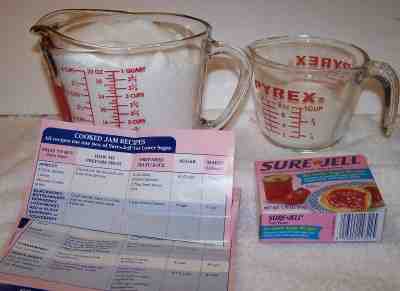 You should only need
3 cups of
sugar.
You should only need
3 cups of
sugar.
If you would rather try to make jam with no added sugar, you might want to try the other strawberry-fig jam recipe using pectin instead of gelatin. I haven't tried making the gelatin type without sugar; it might not set up, but I have tested the pectin type without sugar.
Step 6 - Get the lids warming in hot (but not boiling) water
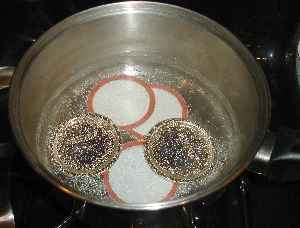 If
you haven't done so already, put the lids into a pan of hot water (barely
simmering) for at least several minutes; to soften up the gummed surface and
clean the lids.
If
you haven't done so already, put the lids into a pan of hot water (barely
simmering) for at least several minutes; to soften up the gummed surface and
clean the lids.
Need lids, rings and replacement jars?


 Get
them all here, delivered direct to your home, at the best prices on the
internet!
Get
them all here, delivered direct to your home, at the best prices on the
internet!
Step 7 - Mix the sugar, jello, figs and strawberries and bring to a full boil
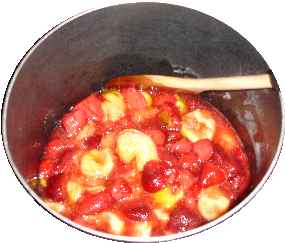 Combine
the sugar, gelatin (jello) strawberries and figs in a large pot. Put the pot on the stove over medium to high heat
(stir often enough to prevent burning). It should take about 5 to 10
minutes to get it to a full boil (the kind that cannot be stirred away).
Combine
the sugar, gelatin (jello) strawberries and figs in a large pot. Put the pot on the stove over medium to high heat
(stir often enough to prevent burning). It should take about 5 to 10
minutes to get it to a full boil (the kind that cannot be stirred away).
Step 8 - Lower the heat and boil for 3 to 5 more minutes
... Lower the heat and continue to boil for 3 to 5 minutes, stirring often!
Then remove from the heat.
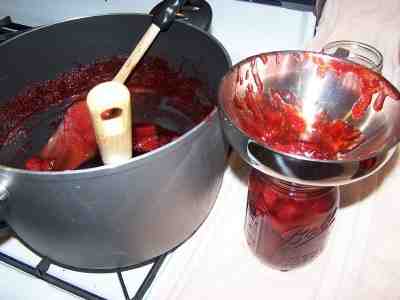 Step
9 - Fill the jars with the hot jam and put the lid and rings on
Step
9 - Fill the jars with the hot jam and put the lid and rings on
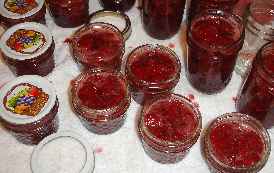 Fill
them to within 1/4-inch of the top, wipe any spilled jam off the top, seat
the lid and tighten the ring around them. Then put the filled jars into the canner!
Fill
them to within 1/4-inch of the top, wipe any spilled jam off the top, seat
the lid and tighten the ring around them. Then put the filled jars into the canner!
This is where the jar tongs come in really handy!
Step 10 - Process the jars in the boiling water bath
Keep the jars covered with at least 2 inches of water. Keep the water
boiling. In general, boil them for 5 to 10 minutes. I say "in general" because you have
to
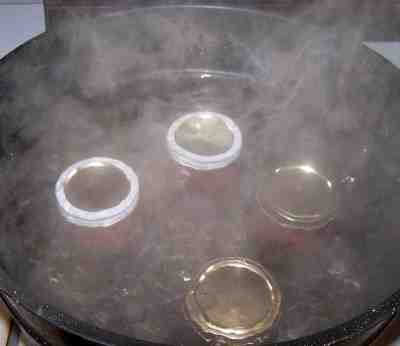 process
(boil) them longer at higher altitudes than sea level, or if you use larger
jars, or if you did not sanitize the jars and lids right before using them.
Clemson
University says you only need to process them for 5 minutes. I usually
hedge my bets and start pulling them out after 5 minutes, and the last jars
were probably in for 10. I rarely have a jar spoil, so it must work.
But you don't want to process them too long, or the jam will turn dark and
get runny. See the chart below for altitude adjustment to processing
times, if you are not in the sea level to 1,000ft above sea level range.
process
(boil) them longer at higher altitudes than sea level, or if you use larger
jars, or if you did not sanitize the jars and lids right before using them.
Clemson
University says you only need to process them for 5 minutes. I usually
hedge my bets and start pulling them out after 5 minutes, and the last jars
were probably in for 10. I rarely have a jar spoil, so it must work.
But you don't want to process them too long, or the jam will turn dark and
get runny. See the chart below for altitude adjustment to processing
times, if you are not in the sea level to 1,000ft above sea level range.
Note: Some people don't even boil the jars; they just ladle it hot into hot jars, put the lids and rings on and invert them, but putting the jars in the boiling water bath REALLY helps to reduce spoilage! To me, it makes little sense to put all the working into making the jam and then not to process the jars to be sure they don't spoil!
|
Recommended process time for jams in a boiling water canner. |
||||
| Process Time at Altitudes of | ||||
| Style of Pack | Jar Size | 0 - 1,000 ft | 1,001 - 6,000 ft | Above 6,000 ft |
| Hot | Half-pints or Pints |
5 min | 10 | 15 |
Step 11 - Remove and cool the jars - Done!
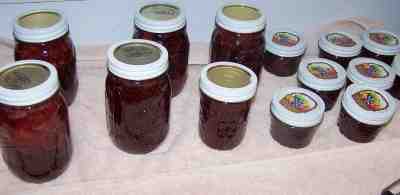 Lift
the jars out of the water with your jar lifter tongs and let them cool
without touching or bumping them in a draft-free place (usually takes
overnight) You can then remove the rings if you like, but if you leave
them on, at least loosen them quite a bit, so they don't rust in place
due to trapped moisture. Once the jars are cool, you can check that they
are sealed verifying that the lid has been sucked down. Just press in
the center, gently, with your finger. If it pops up and down (often
making a popping sound), it is not sealed. If you put the jar in the
refrigerator right away, you can still use it. Some people replace the
lid and reprocess the jar, then that's a bit iffy. If you heat the
contents back up, re-jar them (with a new lid) and the full time in the
canner, it's usually ok.
Lift
the jars out of the water with your jar lifter tongs and let them cool
without touching or bumping them in a draft-free place (usually takes
overnight) You can then remove the rings if you like, but if you leave
them on, at least loosen them quite a bit, so they don't rust in place
due to trapped moisture. Once the jars are cool, you can check that they
are sealed verifying that the lid has been sucked down. Just press in
the center, gently, with your finger. If it pops up and down (often
making a popping sound), it is not sealed. If you put the jar in the
refrigerator right away, you can still use it. Some people replace the
lid and reprocess the jar, then that's a bit iffy. If you heat the
contents back up, re-jar them (with a new lid) and the full time in the
canner, it's usually ok.
Once cooled, they're ready to store. I find they last up to 12 months. But after about 6 to 8 months, they get darker in color and start to get runny. They still are safe to eat, but the flavor and texture aren't as good. So eat them in the first 6 months after you prepare them! Another trick is to keep the uncooked berries or other fruit in the freezer and make and can the jam as needed, so it's always fresh.
FAQS
- Comments from a visitor on July 08, 2011: "I used your recipe last year
for strawberry pie filling. I am down to the last two jars and just canned
some fresh filling. I noticed that the color of last years is more brown
than red. Is it still good? I LOVE your website and refer to it constantly!
Robin Howard
Answer: Yes, over time, the color usually darkens and the jam gets a bit more runny, but if it is still sealed and no other signs of spoilage are present, it's safe to eat!
Comments, Tips and Feedback:
- Comments from a visitor on July 07, 2011: "Thanks so much for the fantastic fig-strawberry jam recipe. I tried it exactly as given here and it is delicious, a good consistency, and it looks beautiful. Also, thanks for the hint to let the cooked mixture sit for 5 minutes so the fruit didn't rise to the top, it worked! I chose to use the 2 1/4 cups of sugar just because sugar is a natural preservative, and the jam is just right. Oh, and, I used frozen strawberries. I had tried somebody else's fig-strawberry jello jam and it was way too sweet. Thanks for a great recipe with lots of good hints. I highly recommend it."
- Comments from a visitor on June 23, 2011: "I just wanted to thank you for your fig recipes and process pages. We have a good sized fig tree out our kitchen window and each year, since the first year of our marriage 12 years ago, I make fig and strawberry fig preserves for my husband. I have tried several recipes for regular fig jam and this one is by far, hands down, my new go to favorite recipes. Easy and Delicious with just right consistency. Also, I've always used the strawberry jello method for strawberry fig jam and usually do not eat it because it is too syrupy sweet for me. This year I made your recipe, I love your quote, there is no jello in preserves, and love, love it. My husband is on a mission trip and is returning tomorrow. I am so excited to share these jams with him. I should get extra bonus points. Thank you again. Oh, and I just made deck jam: That means I only used the figs I could reach from the deck or a chair. The tree is still 3/4 full and most are not even ripe yet. I see more canning in my future.
Summary - Typical Cost of Making Homemade Jam - makes 8 jars, 8 oz each** |
||||
| Item | Quantity | Cost in 2025 | Source | Subtotal |
| Berries (strawberries) | 1 gallon | $8.00/gallon | Pick your own | $8.00 |
| Canning jars (8 oz size), includes lids and rings | 18 jars | $11/dozen 8 oz jars or $0.92/jar |
Grocery stores, like Public, Kroger, Safeway and sometimes, Big Lots, local hardware stores and big box stores | $10.00 |
| Sugar | 4 cups | $2.00 | Grocery stores, like Public, Kroger, Safeway and sometimes, Big Lots, local hardware stores and big box stores | $2.00 |
| Pectin (low sugar, dry) | 1 and a third boxes * | $2.00 per box | Grocery stores, like Public, Kroger, Safeway and sometimes, Big Lots, local hardware stores and big box stores | $2.70 |
| Total | $22.70 total or about $1.25 per jar |
|||
| * pectin use varies - blackberry
jam needs very little, raspberry a little more, strawberry the most.
** - This assumes you already have the pots, pans, ladles,, and reusable equipment. Note that you can reuse the jars and reduce the cost further; just buy new lids (the rings are reusable, but the flat lids are not)! |
||||
Can't find the equipment? We ship to all 50 states!
Use our Feedback form!
FAQs - Answers to Common Questions
- Why should cooked jelly be made in small
batches?
If a larger quantity of juice is used, it will be necessary to boil it longer thus causing loss of flavor, darkening of jelly, and toughening of jelly. It really doesn't work. Trust me; I've tried many times! - Can I use frozen berries instead of fresh?
Yep! Raspberries can be particularly hard to find fresh and are expensive! Frozen berries work just fine, and measure the same. Just be sure to get the loose, frozen whole fruit; not those that have been mushed up or frozen in a sugar syrup! - Should jelly be boiled slowly or rapidly?
It should be boiled rapidly since long, slow boiling destroys the pectin in the fruit juice. - What do I do if there's mold on my jellied
fruit product?
Discard jams and jellies with mold on them. The mold could be producing a mycotoxin (poisonous substance that can make you sick). USDA and microbiologists recommend against scooping out the mold and using the remaining jam or jelly. - Why did my jellied fruit product ferment,
and what do I do?
Jellied fruit products may ferment because of yeast growth. This can occur if the product is improperly processed and sealed, or if the sugar content is low. Fermented fruit products have a disagreeable taste. Discard them. - What happens if my jam or jelly doesn't gel?
Remaking cooked runny jam or jelly instructions can be found on this page
Canning Books, Supplies and Accessories
These are my favorite essential canning tools, books and supplies. I've been using many of these for over 50 years of canning! The ones below on this page are just the sampling of. my preferred tools. but you can find much more detailed and extensive selections on the pages that are linked below.
- Vacuum Foodsealers for freezing, dried foods, and refrigerated foods - the FoodSaver line
- Selecting a KitchenAid mixer and attachments for home canning
- Steam Juicers
- Strainers, pit removers, seed-skin-stem removers, jelly strainers, etc. All types, makes and prices (from $19 to $350)
- Cherry pitters reviews, prices and ordering
- Food dehydrators - easy and fast to dry your own fruits, veggies, sun-dried tomatoes, etc.
The All New Ball Book Of Canning And Preserving: Over 350 of the Best Canned, Jammed, Pickled, and Preserved Recipes Paperback
This is THE book on canning! My grandmother used this book when I was a child.; It tells you in simple instructions how to can almost anything; complete with recipes for jam, jellies, pickles, sauces, canning vegetables, meats, etc.
If it can be canned, this book likely tells you how! Click on the link below for more information and / or to buy (no obligation to buy)The New Ball Blue Book of Canning and Preserving
Canning and Preserving for Dummies by Karen Ward
This is another popular canning book. Click here for more information, reviews, prices for Canning and Preserving For Dummies
Of course, you do not need to buy ANY canning book as I have about 500 canning, freezing, dehydrating and more recipes all online for free, just see Easy Home Canning Directions.
Home Canning Kits
See here for related tools, equipment, supplies on Amazon See here for related tools, equipment, supplies on Amazon
I have several canners, and my favorite is the stainless steel one at right. It is easy to clean and seems like it will last forever. Mine is 10 years old and looks like new.
The black ones are the same type of standard canner that my grandmother used to make everything from applesauce to jams and jellies to tomato and spaghetti sauce.
This complete kit includes everything you need and lasts for years: the canner, jar rack, Jar grabber tongs, lid lifting wand, a plastic funnel, labels, bubble freer, It's much cheaper than buying the items separately. It's only missing the bible of canning, the Ball Blue Book.
You will never need anything else except jars & lids (and the jars are reusable)!
The complete list of canners is on these pages:
- Water bath canners - Good for acidic foods, like applesauce, pickles, salsa, jams, jellies, most fruits
- Pressure canners - needed for low and non-acidic foods, like canned vegetables (corn, green beans, etc), and meats
- Canners for glass top stoves if you have a glass or ceramic stove
- Canners for induction stovetops
Pressure Canners
If you plan on canning non-acidic foods and low acid foods that are not pickled - this means: meats, seafood, soups, green beans corn, most vegetables, etc., then you ABSOLUTELY must use a Pressure Canner.
Of course, you can use a pressure canner as a water bath canner as well - just don't seal it up, so it does not pressurize. This means a Pressure Canner is a 2-in-1 device. With it, you can can almost ANYTHING.
There are also other supplies, accessories, tools and more canners, of different styles, makes and prices, click here!
Basic Canning Accessories
From left to right:
- Jar lifting tongs to pick up hot jars
- Lid sanitizer / lifter - to remove lids from the pot of boiling water (sterilizing )
- Lids- disposable - you may only use them once
- Ring - holds the lids on the jar until after the jars cool - then you remove them, save them and reuse them
- Canning Jar funnel - to fill the jars
FREE Illustrated Canning, Freezing, Jam Instructions and Recipes
Don't spend money on books. that you don't need to. Almost everything you can find in some book sold online or in a store is on my website here for free. Start with theEasy Home Canning Directions below. That is a master list of canning directions which are all based upon the Ball Bblue book, the National Center for Home Food Preservation and other reputable lab tested recipes. Almost every recipe I present in addition to being lab tested com. is in a step by step format with photos for each step and complete. explanations. that tell you how to do it, where to get the supplies and pretty much everything you need to know. In addition, there almost always in a PDF format so you can print them out and use them while you cook.
[ Easy Home Canning Directions]
[FAQs - Answers to common questions and problems]
[Recommended books about home canning, jam making, drying and preserving!]
Looking for canning equipment and supplies?
Water bath canner with a jar rack
Pressure canners for gas, electric and induction stoves: Presto 23Qt or T-fal 22Qt
Canning scoop (this one is PERFECT)
Ball Blue book (most recent version)
Jars: 8oz canning jars for jams
Find Other types of farms:
Farm markets and roadside stands
Road trips and camping resources
Local Honey, apiaries, beekeepers
Consumer fraud and scams information
Home canning supplies at the best prices on the internet!
Maple Syrup Farms, sugarworks, maple syrup festivals
Environmental information and resources
Farms For Your Event for birthday parties, weddings, receptions, business meetings, retreats, etc.
Festivals - local fruit and vegetable festivals
Get the
most recent version of
the Ball Blue Book
With this Presto 23 quart pressure canner and pressure cooker, you can "can" everything, fruits, vegetables, jams, jellies, salsa, applesauce, pickles, even meats, soups, stews. Model 01781

You can make jams, jellies, can fruit, applesauce, salsa and pickles with water bath canners, like this Granite Ware 12-Piece Canner Kit, Jar Rack, Blancher, Colander and 5 piece Canning Tool Set

